Pasadena, California, Hgh State Clinic, Hgh Injections, Hrt Doctors
Pasadena, California Blood Testing Facilities
 Represents a LabCorp blood testing facility
Represents a LabCorp blood testing facility Represents a Quest Diagnostics blood testing facility
Represents a Quest Diagnostics blood testing facility

Nearby Labcorp Blood Testing facilities:
- Labcorp Center Distance: 0 m, 221 E Walnut St Ste 248, Pasadena, Los Angeles County, CA, 91101
- Labcorp Center Distance: 1 m, 50 Alessandro Pl. Suite A10, Pasadena, Los Angeles County, CA, 91105
- Labcorp Center Distance: 3 m, 330 W. Las Tunas Dr. Ste 2, San Gabriel, Los Angeles County, CA, 91776
- Labcorp Center Distance: 5 m, 1809 Verdugo Blvd 290, Glendale, Los Angeles County, CA, 91208
- Labcorp Center Distance: 6 m, 1510 S Central Ave. Ste 520, Glendale, Los Angeles County, CA, 91204
- Labcorp Center Distance: 7 m, 1825 Cesar Chavez Ave, Los Angeles, Los Angeles County, CA, 90033
- Labcorp Center Distance: 9 m, 433 N. 4Th Street Suite 201, Montebello, Los Angeles County, CA, 90640
- Labcorp Center Distance: 10 m, 1400 S Grand Ave Ste 612, Los Angeles, Los Angeles County, CA, 90015
- Labcorp Center Distance: 12 m, 1135 S. Sunset Ave. Ste 403, West Covina, Los Angeles County, CA, 91790
- Labcorp Center Distance: 14 m, 8737 Beverly Blvd Ste 401, Los Angeles, Los Angeles County, CA, 90048
- Labcorp Center Distance: 15 m, 3680 Imperial Hwy Suite 320, Lynwood, Los Angeles County, CA, 90262
- Labcorp Center Distance: 16 m, 3831 Hughes Ave. Ste 607, Culver City, Los Angeles County, CA, 90232
- Labcorp Center Distance: 17 m, 501 E Hardy St. Suite 150, Inglewood, Los Angeles County, CA, 90301
- Labcorp Center Distance: 18 m, 15211 Vanowen St Ste 319, Van Nuys, Los Angeles County, CA, 91405
- Labcorp Center Distance: 19 m, 8540 S Sepulveda Blvd Ste 107, Westchester, Los Angeles County, CA, 90045
- Labcorp Center Distance: 20 m, 1821 Wilshire Blvd. Ste 210, Santa Monica, Los Angeles County, CA, 90403
- Labcorp Center Distance: 21 m, 1950 Sunnycrest Dr. Suite 1800, Fullerton, Orange County, CA, 92835
- Labcorp Center Distance: 22 m, 18399 Ventura Blvd. Suite 17, Tarzana, Los Angeles County, CA, 91356
- Labcorp Center Distance: 23 m, 10861 Cherry St. Suite 200, Los Alamitos, Orange County, CA, 90720
- Labcorp Center Distance: 24 m, 1201 N. Rose Dr. Suite 202, Placentia, Orange County, CA, 92870
- Labcorp Center Distance: 25 m, 3500 Lomita Blvd. Suite 102, Torrance, Los Angeles County, CA, 90505
- Labcorp Center Distance: 26 m, 1661 Golden Rain Rd, Seal Beach, Orange County, CA, 90740
- Labcorp Center Distance: 27 m, 12555 Central Ave. Ste Af, Chino, San Bernardino County, CA, 91710
- Labcorp Center Distance: 28 m, 9191 Westminster Ave. Ste 104, Garden Grove, Orange County, CA, 92844
- Labcorp Center Distance: 29 m, 1310 San Bernardino Rd Ste 107, Upland, San Bernardino County, CA, 91786
- Labcorp Center Distance: 30 m, 705 W La Veta Ave Ste 102, Orange, Orange County, CA, 92868
- Labcorp Center Distance: 31 m, 17822 Beach Bl Suite 242, Huntington Beach, Orange County, CA, 92647
- Labcorp Center Distance: 32 m, 100 N. Tustin Avenue, Tustin, Orange County, CA, 92780
- Labcorp Center Distance: 33 m, 10801 Foothill Blvd Ste 105, Rancho Cucamonga, San Bernardino County, CA, 91730
- Labcorp Center Distance: 34 m, 28240 Agoura Road Suite 204, Agoura Hills, Los Angeles County, CA, 91301
- Labcorp Center Distance: 36 m, 43839 15Th St West, Lancaster, Los Angeles County, CA, 93534
- Labcorp Center Distance: 37 m, 2655 First St. Suite 340, Simi Valley, Ventura County, CA, 93065
- Labcorp Center Distance: 38 m, 900 S. Main St. Suite 207, Corona, Riverside County, CA, 92882
- Labcorp Center Distance: 39 m, 800 Magnolia Ave Ste 108, Corona, Riverside County, CA, 92879
- Labcorp Center Distance: 40 m, 1401 Avocado Ave. Ste 208, Newport Beach, Orange County, CA, 92660
- Labcorp Center Distance: 41 m, 425 Haaland Dr. Ste 106, Thousand Oaks, Ventura County, CA, 91361
- Labcorp Center Distance: 42 m, 865 Patriot Drive Suite 101, Moorpark, Ventura County, CA, 93021
- Labcorp Center Distance: 43 m, 558 N. Ventu Park Rd. Suite C, Newbury Park, Ventura County, CA, 91320
- Labcorp Center Distance: 44 m, 6927 Brockton Ave Ste 1B, Riverside, Riverside County, CA, 92506
- Labcorp Center Distance: 46 m, 29873 Santa Margarita Pkwy102, Rancho Santa Margarita, Orange County, CA, 92688
- Labcorp Center Distance: 48 m, 26691 Plaza Drive Suite 180, Mission Viejo, Orange County, CA, 92691
- Labcorp Center Distance: 49 m, 399 E. Highland Ave. Ste 510, San Bernardino, San Bernardino County, CA, 92404
- Labcorp Center Distance: 52 m, 17450 Main St. Suite C, Hesperia, San Bernardino County, CA, 92345
- Labcorp Center Distance: 53 m, 12332 Hesperia Rd Suite B, Victorville, San Bernardino County, CA, 92395
- Labcorp Center Distance: 54 m, 12677 Hesperia Rd. Suite 170A, Victorville, San Bernardino County, CA, 92395
- Labcorp Center Distance: 55 m, 665 Camino De Los Mares 303A, San Clemente, Orange County, CA, 92673
- Labcorp Center Distance: 56 m, 16008 Kamana Dr. Suite 201, Apple Valley, San Bernardino County, CA, 92307
- Labcorp Center Distance: 57 m, 18522 Us Highway 18 Ste 104, Apple Valley, San Bernardino County, CA, 92307
- Labcorp Center Distance: 58 m, 31571 Canyon Estates Dr Ste101, Lake Elsinore, Riverside County, CA, 92532
- Labcorp Center Distance: 59 m, 300 South A St 103, Oxnard, Ventura County, CA, 93030
- Labcorp Center Distance: 63 m, 34845 Yucaipa Bl. Ste B, Yucaipa, San Bernardino County, CA, 92399
Nearby Quest Blood Testing facilities:
- Quest Center Distance: 0 m, 960 E. Green St., Pasadena, Los Angeles County, CA, 91106-2405
- Quest Center Distance: 3 m, 416 W Lastunas Dr, San Gabriel, Los Angeles County, CA, 91776-1236
- Quest Center Distance: 5 m, 801 S Chevy Chase Dr, Glendale, Los Angeles County, CA, 91205-4437
- Quest Center Distance: 8 m, 420 E 3Rd St, Los Angeles, Los Angeles County, CA, 90013-1646
- Quest Center Distance: 9 m, 1127 Wilshire Blvd, Los Angeles, Los Angeles County, CA, 90017-3901
- Quest Center Distance: 14 m, 8501 Wilshire Blvd, Beverly Hills, Los Angeles County, CA, 90211-3117
- Quest Center Distance: 15 m, 15141 Whittier Blvd, Whittier, Los Angeles County, CA, 90603-2158
- Quest Center Distance: 22 m, 18250 Roscoe Blvd, Northridge, Los Angeles County, CA, 91325-4265
- Quest Center Distance: 24 m, 520 N Prospect Ave, Redondo Beach, Los Angeles County, CA, 90277-3043
- Quest Center Distance: 25 m, 23441 Madison St, Torrance, Los Angeles County, CA, 90505-4735
- Quest Center Distance: 26 m, 4028 Grand Ave, Chino, San Bernardino County, CA, 91710-5486
- Quest Center Distance: 29 m, 1399 E Foothill Blvd, Upland, San Bernardino County, CA, 91786-4060
- Quest Center Distance: 32 m, 801 N Tustin Ave, Santa Ana, Orange County, CA, 92705-3607
- Quest Center Distance: 35 m, 2876 Sycamore Dr, Simi Valley, Ventura County, CA, 93065-1550
- Quest Center Distance: 38 m, 1220 La Venta Dr., Westlake Village, Ventura County, CA, 91361-3749
- Quest Center Distance: 43 m, 9041 Magnolia Ave, Riverside, Riverside County, CA, 92503-3956
- Quest Center Distance: 44 m, 23521 Paseo De Valencia, Laguna Hills, Orange County, CA, 92653-3673
- Quest Center Distance: 45 m, 4646 Brockton Ave, Riverside, Riverside County, CA, 92506-0103
- Quest Center Distance: 49 m, 2150 N Waterman Ave, San Bernardino, San Bernardino County, CA, 92404-4811
- Quest Center Distance: 51 m, 6485 Day St, Riverside, Riverside County, CA, 92507-0926
- Quest Center Distance: 52 m, 500 Paseo Camarillo, Camarillo, Ventura County, CA, 93010-5900
- Quest Center Distance: 53 m, 12370 Hesperia Rd, Victorville, San Bernardino County, CA, 92395-4787
- Quest Center Distance: 59 m, 32251 Mission Trl, Lake Elsinore, Riverside County, CA, 92530-4536
- Quest Center Distance: 70 m, 807D Tucker Rd, Tehachapi, Kern County, CA, 93561-2510
- Quest Center Distance: 71 m, 27699 Jefferson Ave, Temecula, Riverside County, CA, 92590-2696
- Quest Center Distance: 82 m, 3601 Vista Way, Oceanside, San Diego County, CA, 92056-4559
- Quest Center Distance: 90 m, 477 N El Camino Real, Encinitas, San Diego County, CA, 92024-1353
- Quest Center Distance: 93 m, 3905 State St, Santa Barbara, Santa Barbara County, CA, 93105-5101
- Quest Center Distance: 94 m, 555 E Tachevah Dr, Palm Springs, Riverside County, CA, 92262-5750
- Quest Center Distance: 99 m, 57370 29 Palms Hwy, Yucca Valley, San Bernardino County, CA, 92284-2900
Pasadena California Hormone Replacement Therapy Services
As you grow older, it becomes more important for you to take active steps to preserve and even enhance your health. The Conscious Evolution Institute understands the importance of having a proactive plan when it comes to protecting health and vitality into old age. That is the reason that we offer the potentially life-changing HRT Programs that we do. Hormone Balance is among the most important factors as it relates to being healthy and staying healthy as you grow older. We are proud to offer our services to the people of Pasadena California, and we also offer HRT Services to patients all throughout California. Our Pasadena Hormone Clinic accepts patients thirty years of age and older.
Simply by giving us a call or filling out the form on this page, you can get started with a 21st century Hormone Optimization Program. We will arrange for a meeting with one of our qualified affiliates in your area, and they will take a blood sample and will give you a routine physical, all of which will be analyzed in order to provide us with a full and total picture of your underlying Hormone Levels and other factors associated with your health and vitality. If our analysis shows that you can benefit from Hormone Replacement with Testosterone, Human Growth Hormone, or any other HRT Treatment, we can write you a prescription and work with you to set up a Comprehensive Hormone Plan that will maximize the effectiveness of your Hormone Treatment! We look forward to providing you with the best HRT Services available in Los Angeles County!
Pasadena California HGH Treatments for Growth Hormone Deficiency
One of our most asked-about treatment options is HGH Injection Therapy. Human Growth Hormone is among the most important hormones that directly relate to your ability to age gracefully. Human Growth Hormone is vitally important because it is the body's primary mechanism to modulate cellular metabolism. HGH Deficiency has a major impact on a patient's health, and this Hormone Deficiency becomes increasingly likely with every year that you grow older, beginning around the age of thirty.
If you have experienced a combination of weight gain, loss of muscle mass, reduced immune capacity, slow healing, depression, and mild cognitive in recent months or years, there is a significant chance that you could be suffering from Age-Associated Growth Hormone Deficiency, also known as Somatopause.
If you are interested in Pasadena HGH Injections, we offer a number of common HGH Brands including Nutropin, Saizen, and Humatrope. These companies also offer devices which simplify the injection process and minimize discomfort.
Pasadena California Sermorelin Acetate HGH Alternative
Of course, there is another option on the table for patients that are interested in boosting HGH Levels, namely in the form of Recombinant Sermorelin. Sermorelin Acetate is a functionally identical analogue of a naturally-occuring HGH Precursor Hormone known as GH-RH, or Growth Hormone-Releasing Hormone. Sermorelin stimulates the Pituitary to elevate natural Growth Hormone Production to healthy levels. Sermorelin is shown to be clinically effective, as effective as Real HGH. Sermorelin is actually a cost-effective alternative, and can be prescribed off-label, which allows our Pasadena HGH Doctors the full authority to provide you with HGH Restoration if they feel you can benefit!
Pasadena California Testosterone Replacement Therapy for Andropause and Low-T
Healthy Testosterone Levels are the key to maintaining male masculinity and virility throughout one's life. Testosterone Deficiency is a major health issue that impacts hundreds of thousands of men across California, if not millions. Low-T is commonly known as a condition which limits sexual desire and function, but it actually affects many different areas of men's health. Age-Related Testosterone Deficiency is also known as Andropause, and has a variety of symptoms, not only erectile dysfunction and loss of sex drive, but also symptoms such as mood instability, lack of confidence, loss of muscle mass, increased bellyfat, and more. Low-T is strongly associated with diabetes, obesity, heart attack, stroke, and more.
Luckily, it is easier than ever to treat Testosterone Deficiency with Bio-Identical Testosterone Therapy. Our Pasadena Testosterone Doctors can help you start an HRT Program with Testosterone Creams, Low-T Patches, or biweekly Testosterone Injections that will elevate your Testosterone Levels to a level associated with early adulthood. A six-month regimen of Recombinant Testosterone has been shown to mitigate or even reverse most of the health issues associated with Testosterone Deficiency, increasing your sexual desire and ability while potentially vastly improving your overall health profile!
Pasadena California Information and Landmarks
Pasadena is one of the many suburbs of Los Angeles, and one of the most well-known. The city of Pasadena is actually the second oldest city in the Los Angeles Area, being only L.A. Pasadena is located northeast of Los Angeles, in the San Gabriel Valley, and is directly adjacent to Altadena, Glendale, and Alhambra. Pasadena has many nicknames. Including the Dena, Rose Town, Crown City, and the City of Roses. Pasadena is located just to the south of Mount San Antonia, largely, but not entirely, separated by Altadena. Neighborhoods in Pasadena include Orange Heights, South Arroyo, Oak Knoll, North Central, Chapman, Mid Central, Linda Vista, Washington Square, North Arroyo, Lamanda Park, Old Pasadena, and Bungalow Heaven.
Perhaps the most well-known landmark in Pasadena is the Rose Bowl, the football stadium which hosts the Rose Bowl Game. The Rose Bowl regularly hosted the national BCS Championship Game four times, and is one of the available venues for the College Football Playoff Championship game. Other places of interest in Pasadena include the USC Pacific Asia Museum, the Norton Simon Museum, the Pasadena Playhouse, the Art College of Design, the Huntington Library and Botanical Gardens, and the Fuller Theological Seminary. Pasadena has a burgeoning artist community, and is home to both the Pasadena Society of Artists and the California Art Club.
Places of higher education include Pasadena City College and the California Institute of Technology. Among the major private employers in Pasadena are Bank of America, AT&T, Kaiser Permanente, and the Jet Propulsion Laborotory.
All About Pasadena, California Geographic Area
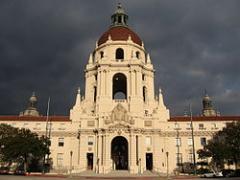

Pasadena ( /ËupR¦sÉoËndiËanÉo/) is a city in Los Angeles County, California, United States. As of 2010 United States Census, the population of Pasadena was 137,122, making it the 180th-largest city in the United States, down from 168th place in 2009. Pasadena is the ninth-largest city in Los Angeles County, and on June 19, 1886, became the fourth to be incorporated in Los Angeles County, after Anaheim (March 18, 1876) and Santa Ana (June 1, 1886), which were part of Los Angeles County until Orange County was formed in 1889. It is one of the primary cultural centers of the San Gabriel Valley.
/ËupR¦sÉoËndiËanÉo/) is a city in Los Angeles County, California, United States. As of 2010 United States Census, the population of Pasadena was 137,122, making it the 180th-largest city in the United States, down from 168th place in 2009. Pasadena is the ninth-largest city in Los Angeles County, and on June 19, 1886, became the fourth to be incorporated in Los Angeles County, after Anaheim (March 18, 1876) and Santa Ana (June 1, 1886), which were part of Los Angeles County until Orange County was formed in 1889. It is one of the primary cultural centers of the San Gabriel Valley.
Although famous for hosting the annual Rose Bowl football game and Tournament of Roses Parade, Pasadena is also the home to many scientific and cultural institutions, including the California Institute of Technology (Caltech), the Jet Propulsion Laboratory (actually in La CaR±ada Flintridge), Pasadena City College (PCC), Fuller Theological Seminary, Art Center College of Design, the Pasadena Playhouse, the Norton Simon Museum of Art and the Pacific Asia Museum.
The 2010 United States Census reported that Pasadena had a population of 137,122. The population density was 5,928.8 people per square mile (2,289.1/km ²). The racial makeup of Pasadena was 76,550 (55.8%) White, 14,650 (10.7%) African American, 827 (0.6%) Native American, 19,595 (14.3%) Asian, 134 (0.1%) Pacific Islander, 18,675 (13.6%) from other races, and 6,691 (4.9%) from two or more races. Hispanic or Latino of any race were 46,174 persons (33.7%). Non-Hispanic Whites were 38.8% of the population in 2010, down from 70.4% in 1970.
The Census reported that 133,629 people (97.5% of the population) lived in households, 2,472 (1.8%) lived in non-institutionalized group quarters, and 1,021 (0.7%) were institutionalized.
There were 55,270 households, out of which 14,459 (26.2%) had children under the age of 18 living in them, 22,285 (40.3%) were married couples living together, 6,131 (11.1%) had a female householder with no husband present, 2,460 (4.5%) had a male householder with no wife present. There were 3,016 (5.5%) unmarried partnerships. 18,838 households (34.1%) were made up of individuals and 5,748 (10.4%) had someone living alone who was 65 years of age or older. The average household size was 2.42. There were 30,876 families (55.9% of all households); the average family size was 3.18.
The population was spread out with 26,507 people (19.3%) under the age of 18, 12,609 people (9.2%) aged 18 to 24, 45,371 people (33.1%) aged 25 to 44, 34,073 people (24.8%) aged 45 to 64, and 18,562 people (13.5%) who were 65 years of age or older. The median age was 37.2 years. For every 100 females there were 95.1 males. For every 100 females age 18 and over, there were 93.5 males.
There were 59,551 housing units at an average density of 2,574.8 per square mile (994.1/km ²), of which 24,863 (45.0%) were owner-occupied, and 30,407 (55.0%) were occupied by renters. The homeowner vacancy rate was 2.3%; the rental vacancy rate was 6.6%. 64,306 people (46.9% of the population) lived in owner-occupied housing units and 69,323 people (50.6%) lived in rental housing units.
About 11.6% of families and 15.9% of the population were below the poverty line, including 21.3% of those under age 18 and 10.5% of those age 65 or over.
Pasadena is located at 34 °9 a²22 a³N 118 °7 a²55 a³W / 34.15611 °N 118.13194 °W / 34.15611; -118.13194 (34.156098, -118.131808). The elevation at City Hall is 864 feet (263 m) above sea level. The greater Pasadena area is bounded by the Raymond Fault line, the San Rafael Hills, and the San Gabriel Mountains. The Arroyo Seco, a major geographic feature and home of the Rose Bowl, flows from headwaters in Pasadena's towering Angeles National Forest greenbelt in the San Gabriel Mountains.
According to the United States Census Bureau, the city has a total area of 23.1 square miles (60 km2), over 99% of it land; 0.68% is water.
Ten miles (16 kilometers) northeast of downtown Los Angeles, Pasadena is bordered by 11 communities: Highland Park, Eagle Rock, South Pasadena, San Marino, Temple City, San Gabriel, Arcadia, Sierra Madre, La CaR±ada Flintridge, and Altadena. The communities of Eagle Rock, Highland Park and Garvanza are incorporated within the city of Los Angeles and Altadena is an unincorporated part of Los Angeles County.
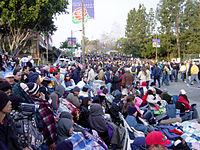
Pasadena is home to the Tournament of Roses Parade, held each year on January 1 (or on January 2, if the 1st falls on a Sunday). The first parade was held in 1890 and was originally sponsored by the Valley Hunt Club, a Pasadena social club. The motivation for having the parade was, as member Professor Charles F. Holder said, "In New York, people are buried in snow. Here our flowers are blooming and our oranges are about to bear. Let's hold a festival to tell the world about our paradise."
By 1895, the festivities had outgrown the Valley Hunt Club, and the Tournament of Roses Association was formed to take charge of the parade. The Rose Parade, as it is familiarly known, traditionally features elaborate floats. According to the organizers, "Every inch of every float must be covered with flowers, or other natural materials, such as leaves, seeds, or bark. On average a float requires about 100,000 flowers and greenery. Volunteer workers swarm over the floats in the days after Christmas, their hands and clothes covered with glue and petals." The most perishable flowers are placed in small vials of water, which are placed onto the float individually. Over the almost 3 hours of the parade, floats, and participants travel over five miles (8 km) and pass by over one million viewers who traditionally camp out over New Year's Eve to have the best view along the parade route.
The Rose Parade is satirized by the popular Doo Dah Parade, an annual event that originated in Old Pasadena in 1978, and soon gained national notoriety. Readers Digest named the Doo Dah Parade auAmerica aos Best Parade au, and was a recent feature in 50 Places You Must Visit Before You Die!. It was formerly held around Thanksgiving, a month before the Rose Parade, but the parade is now held in May. In 2011, after 33 years in Pasadena, the parade moved to East Pasadena for the first time. It features unusual and absurd entrants such as the BBQ & Hibachi Marching Grill Team, the Men of Leisure, and the Bastard Sons of Lee Marvin. Proceeds from the parade's pancake breakfast, t-shirts, and after-party are donated to charity.
The Rose Bowl, a National Historic Landmark, is host of the first, oldest, and most famous college football postseason bowl game, the Tournament of Roses Rose Bowl Game, every New Year's Day. In 1895, the Tournament of Roses Association was formed to take charge of the parade. In 1902, the association declared that a football game would be added to the day's events. The game, now known as the Rose Bowl, would become the first New year's post-season college football game ever and has developed into a tradition in many college arenas. Soon outgrowing its original facility, a new stadium was constructed in the Arroyo Seco area. The new stadium hosted its first New Year's Day football game in 1923 and was soon christened "The Rose Bowl."
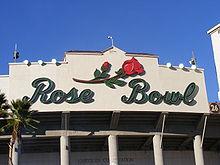
In addition to the annual New Year's Day Rose Bowl game and the BCS National Championship game every four years, the stadium is the home field for the UCLA Bruins football team and has hosted five Super Bowls. Important soccer matches include the 1984 Summer Olympics, the final game of the 1994 FIFA World Cup, and the final game of the 1999 FIFA Women's World Cup.
The Rose Bowl stadium was the home ground for the Los Angeles Galaxy of Major League Soccer from the team's inception in 1996 until in 2003, it moved into the soccer-specific Home Depot Center in Carson, California. The venue additionally hosted the 1998 MLS Cup. Many concerts and other events have been held in the stadium, such as a U2 concert in 2009.
The Rose Bowl Aquatics Center is an aquatics facility located adjacent to the Rose Bowl Stadium. The pool hosted the final practices of the 2000 US Olympic swimming and diving team. In 2008, the facility held the U.S. National Diving Championships. The Rose Bowl Tennis Center, operated by the city of Pasadena, is located due south of the Rose Bowl stadium.
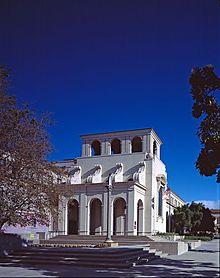
Federally, Pasadena is located in California's 29th congressional district, which has a Cook PVI of D +12 and is represented by Democrat Adam Schiff. Although Pasadena has been liberal in state politics, in national politics, it was a stronghold for moderate Republicans; it was represented in Congress by Republicans from 1945 to 2001. In the state legislature, Pasadena is located in the 21st Senate District, represented by Democrat Carol Liu, and in the 44th Assembly District, represented by Democrat Anthony J. Portantino. The Los Angeles County Department of Health Services operates the Monrovia Health Center in Monrovia, serving portions of Pasadena.
According to the city's most recent Comprehensive Annual Financial Report of 2009, the city's various funds had $583.0 million in revenues, $518.1 million in expenditures, $954,199,439 in net assets, $732.3 million in total liabilities, and $118,261,490 in cash and investments.
The Pasadena Police Department serves most of the city of Pasadena. Unincorporated portions of the city are part of Los Angeles County and are served by the Los Angeles County Sheriff's Department (LASD) and the Altadena Station in Altadena serves nearby portions of Pasadena.
The Pasadena Fire Department moved into its first formal and permanent station in 1889. Before that they had been housed in a ramshackle structure and summoned by the church bell. There were 24 firemen for two shifts. Today The Pasadena Fire Department consists of 185 full-time employees, 153 shift personnel, 32 administrative personnel, and eight modern fire stations that serve an area in a radius of 60 miles (97 km).
Pasadena Water and Power Department (PWP) provides services to an area 60 km2 (23 sq mi) and includes areas outside of the city proper including unincorporated areas of southern Altadena, East Pasadena, Chapman Woods, and East San Gabriel.
Pasadena created the Pasadena Municipal Light and Power Department in 1906. On May 3, 1906, a $125,000 bond was issued to pay for the construction of a power plant. This first power plant was a wood frame and corrugated sheet iron structure which housed one 200-kW Crocker-Wheeler generator driven by a Fleming-Corliss engine, one 200-pound pressure boiler, a condenser, pumps, and other auxiliary equipment and only supplied power to the city's street lights. Expanding continued and more generating capacity was expanded and the city then offered power to commercial customers in 1908, and bought out Southern California Edison's Pasadena operations in 1920. In 1928 the city contracted with the federal government to buy electricity from Boulder Dam, later renamed Hoover Dam, which began delivering power in 1935.
During the Depression the power company extended its building programs to provide short term jobs for citizens severely affected by the collapse of the economy. Customers were permitted to work for the company for two week periods to earn money for food, utility bills and housing. Following many further improvements, two 50,000 kW generating units in a completely new outdoor plant went on-line in 1955 and 1958. In June 1965, a 71 MW, 83 MVA reheat unit with steam backup auxiliaries was put into service to cover the growing needs for more power in the city.
In 1911, the city began condemnation actions against a number of small, local water companies. In 1912, the Water Department was created; in 1913, it began actual operations. The city continued to acquire small, local water companies for several decades afterwards, usually en toto, such as the Pasadena Lake Vineyard and Land Company, and sometimes in part, such as Las Flores Water Company's southern portions and San Gabriel Valley Water Company's operations in the southern reaches of Pasadena. In 1915, the Water Department added a chlorine generation system (from the Electro Beaching Gas Company of New York) to disinfect water taken from the Arroyo Seco. In the late 1920s, Pasadena took the initiative to obtain water from the Colorado River and lead the formation of the Metropolitan Water District of Southern California (MWDSC or "Met"). The charter for the MWDSC was signed on November 6, 1928. In 1967, the Water Department and the Light and Power department were consolidated into the "Pasadena Water and Power Department" (or PWP).
It operates a number of wells, has a spreading ground for the capture of surface water from the Arroyo Seco, and purchases surface water from MWDSC. Historically, water from the Arroyo Seco and Eaton Canyon were collected and distributed directly to the service areas. Not long after the city took over operations, 1915, chlorine was added to the Arroyo Seco water. In 1971 the John Behner Treatment Plant was constructed to give full surface water treatment to the Arroyo Seco water. Eventually as regulatory limits were made stricter, PWP ceased all direct surface water treatment. The use of spreading grounds to recharge ground water on both the Arroyo Seco and Eaton Canyon capture considerable volumes of water, a little over 2,000 acre feet (2,500,000 m3) per year.
A number of wells on the west side of the service area had become contaminated with volatile organic chemicals and perchlorate and had to be shut down several years. A treatment plant was built to remove these chemicals which began operation in July 2011.
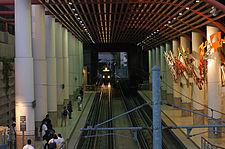
Pasadena is the northern terminus of the Los Angeles Metro Gold Line light rail, which originates at the Atlantic Station in East Los Angeles. Opening in 2003, there are currently six Gold Line stations in Pasadena: Fillmore Station, Del Mar Station in Old Pasadena, Memorial Park Station in Old Pasadena, Lake Station in Downtown, Allen Station and Sierra Madre Villa Station. Construction began in June 2010 to extend the Gold Line east through several additional foothill communities of the San Gabriel Valley.
Pasadena is also served by various bus services. The Pasadena Area Rapid Transit System exclusively serves the city while Los Angeles metropolitan area bus services Foothill Transit, LADOT, Metro Local, Metro Express, Metro Rapid also serve Pasadena.
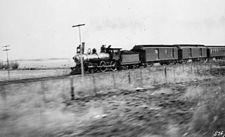
Pasadena was served by the Atchison, Topeka and Santa Fe Railway at a Santa Fe Depot in downtown when the Second District was opened in 1887. In 1925, the historical and traditionally-styled station in Pasadena was opened. Originally, the Second District was an invaluable line; it served manufacturing and agricultural businesses throughout the entire San Gabriel Valley. Unfortunately, the longer trains had great difficulty climbing the precipitous 2.2% grade at Arroyo Seco, between Pasadena and Los Angeles. Additional locomotives were often necessary, causing a more costly and less efficient operation. The still-used Third District opened in 1888, just a year after the Second District, and rapidly took over most of longer freight trains more efficaciously.
The Second District and the Pasadena Depot became well known by the many transcontinental passenger trains that it served. Historically, up to 26 passenger trains went through Pasadena every day. To avoid the media in Los Angeles, many celebrities chose to use Pasadena as their main train station, bringing to it an ambience and legacy of the glamour of old Hollywood.
Amtrak took over passenger rail operations in 1971, serving Pasadena with trains such as the Southwest Chief, Las Vegas Limited, and Desert Wind. On January 15, 1994, the final Southwest Chief train arrived in Pasadena. ATSF sold the line between Los Angeles and San Bernardino via Pasadena (known as the "second division"). (Now the Southwest Chief operates over the transcon via Fullerton.) The LACMTA Gold Line still uses the same right-of-way (although different tracks) as the Santa Fe did. The old depot is still visible at the Del Mar station.
Bob Hope Airport (also known as Burbank-Glendale-Pasadena Airport) in nearby Burbank serves as the regional airport for Pasadena. The airport is owned and operated by the Burbank-Glendale-Pasadena Airport Authority. The airport is under the control of the governments of the three cities for which it is named. Most destinations from Bob Hope Airport are within the United States, so Los Angeles International Airport in Los Angeles and LA/Ontario International Airport in Ontario are also important airports less than an hour from Pasadena. Long Beach Airport in Long Beach, California, is about an hour's drive away. John Wayne Airport in Orange County, California, is slightly more than an hour aos drive away from Pasadena.
Four freeways run through Pasadena, and Pasadena is a control city for all of them. The most important is the Foothill Freeway (I-210) which enters the northwestern portion of the city from La CaR±ada Flintridge. The Foothill Freeway initially runs due south, passing the Rose Bowl before its junction with the Ventura Freeway. At this interchange, the Foothill Freeway shifts its alignment and direction, becoming an east-west freeway, exiting the city on its eastern boundary before entering Arcadia. The Foothill Freeway connects Pasadena with San Fernando (westbound) and San Bernardino (eastbound).
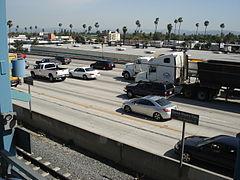
The Ventura Freeway (SR 134) starts at the junction of the Foothill Freeway (I-210) at the edge of downtown Pasadena and travels westward. This freeway is the main connector to Bob Hope Airport and the San Fernando Valley.
A spur of the controversial Long Beach Freeway (SR 710 in Pasadena) is also located in Pasadena. The Long Beach Freeway was intended to connect Long Beach to Pasadena but a gap, known as the South Pasadena Gap, between Alhambra and Pasadena has not been completed due to legal battles primarily involving the city of South Pasadena. The spur starts at the junction of the Ventura Freeway and Foothill Freeway and travels south along the eastern edge of Old Pasadena with two exits for Colorado Boulevard and Del Mar Boulevard before ending at an at-grade intersection with California Boulevard. Currently, Caltrans is researching the possibility of using advanced tunneling technologies to build the Long Beach Freeway underground to overcome objections, but that effort itself has engendered strong oppposition. The current proposal would create twin tunnels that are 4.5 miles (7.2 km) long, the longest in the United States.
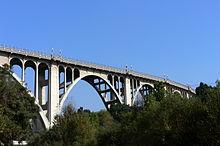
The Arroyo Seco Parkway (SR 110) (also known as the Pasadena Freeway) is the first freeway in California, connecting Los Angeles with Pasadena alongside the Arroyo Seco and is the primary access to Downtown Los Angeles. The freeway enters the southern part of the city from South Pasadena. Only one exit is actually inside city limits, the southbound exit connecting to State Street with access to Fair Oaks Avenue. At Glenarm Street, the freeway ends and the four-lane Arroyo Parkway continues northward to Old Pasadena.
Three state highways enter the city of Pasadena. Arroyo Parkway (SR 110), maintained by the city of Pasadena, runs from the termination of the Pasadena Freeway at Glenarm Street to Colorado Boulevard in Old Town Pasadena. While Arroyo Parkway continues north two more blocks, SR 110 ends at Holly Street.
Rosemead Boulevard (SR 19) is a state highway on the eastern edge of Pasadena and unincorporated Pasadena from Huntington Drive to Foothill Boulevard.
An obscure portion of the Angeles Crest Highway (SR 2) in the San Gabriel Mountains cuts through Pasadena near the Angeles Crest Ranger Station. This 2-mile (3.2 km) stretch of highway in the Angeles National Forest is north of La CaR±ada Flintridge and west of Mount Wilson and is approximately 3,000 feet (910 m) in elevation.
Historic U.S. Route 66 used to run through Pasadena until it was decommissioned in 1964. The historic highway entered Pasadena from the east on Colorado Boulevard and then jogged south on Arroyo Parkway before becoming part of the Pasadena Freeway (SR 110).
The intersection of Fair Oaks Avenue and Colorado Boulevard in Old Pasadena is the zero-zero, east-west, north-south postal division of Pasadena.
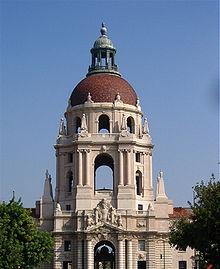
The Pasadena Symphony, founded in 1862, offers several concerts a year at the Ambassador Auditorium and the Pasadena Pops plays at the Los Angeles County Arboretum and Botanic Garden. The Civic Center also holds a few traveling Broadway shows each year. The legendary Pasadena Playhouse, presently in reorganization, usually presents seven shows a season, each show running six to eight weeks. The Furious Theatre Company is one of several small theatre companies in Pasadena. They are currently housed in the Carrie Hamilton Theatre adjacent to the Pasadena Playhouse. Boston Court Performing Arts Center, opened in 2003, is near Lake and Colorado. Its resident theatre company, the award-winning The Theatre @ Boston Court presents four productions a year. Music at the Court presents numerous music concerts each year, ranging from classical to jazz. The Friends of the Levitt organization presents a free summer concert series in Memorial Park, with the 2008 summer season marking its sixth year.
Beckman Auditorium and other venues on the Caltech campus present a wide range of performing arts, lectures, films, classes and entertainment events, primarily during the academic year.
For more than ten years, twice annually Pasadena's cultural institutions have opened their doors for free during ArtNight Pasadena, offering the public a rich sampling of quality art, artifacts and music within the city. This has evolved into the yearly PasadenART Weekend, a three day citywide event which, as of 2007, encompasses ArtNight, ArtWalk, ArtHeritage, ArtMarket, and ArtPerformance, a vibrant outdoor music event showcasing emerging and nationally recognized talent. Free concerts take place on multiple stages throughout Old Pasadena.

Ambassador Auditorium was built under the guidance of Herbert W. Armstrong as both a facility to be used by the Worldwide Church of God for religious services and as a concert hall for public performances celebrating the performing arts. In 2007, the native Pasadena band Ozma reunited and produced the album Pasadena in tribute to the city. The album photos and artwork were shot at the Colorado Street Bridge.
The 1960s song "The Little Old Lady from Pasadena" parodies a popular Southern California image of Pasadena as home to a large population of aged eccentrics. In the song, Jan and Dean sing of an elderly lady who drives a powerful "Super Stock Dodge" muscle car and is "the terror of Colorado Boulevard." The Dead Kennedys paid a tribute to this archetypal song in the track "Buzzbomb From Pasadena" in the album Give Me Convenience or Give Me Death. Pasadena was also the location of the 2012 film Project X.
A number of artists of national repute, such as Guy Rose, Alson S. Clark, Marion Wachtel and Ernest A. Batchelder, of the Arts and Crafts Movement, made Pasadena their home in the early twentieth century. The formation of the California Art Club, Pasadena Arts Institute and the Pasadena Society of Artists heralded the city's emergence as a regional center for the visual arts.
Pasadena is home to a number of art museums and public galleries, including the Norton Simon Museum. The museum's collections include European paintings, sculpture, and tapestry; sculpture from Southern Asia; and an extensive sculpture garden. The museum also has the contemporary art collection of its predecessor, the Pasadena Museum of Art, which focused on modern and contemporary art before being taken over by Simon in the early 1970s.
Preserving and sharing the rich history and culture of Pasadena and its adjacent communities is the Pasadena Museum of History. Located on a campus of 2 acres (8,100 m2), it has gardens, a history center, the Finnish Folk Art Museum, the Curtin House, and the Fenyes Mansion, a 1906 Beaux Arts-style architectural residence and a Pasadena Cultural Heritage Landmark.
The Pacific Asia Museum, with a garden courtyard in its center, features art from the many countries and cultures of Asia. The nearby Pasadena Museum of California Art hosts changing exhibitions of work by historical and contemporary California artists. The Armory Center for the Arts has an extensive exhibition program as well as serving as a center for art education for all ages. Art Center College of Design offers exhibitions at its Williamson Gallery, as well as frequent displays of student work. Pasadena City College has an art gallery that shows work of professionals as part of their annual artist-in-residence program, as well as exhibiting work by students and faculty.
The Huntington Library and Botanical Gardens, with painting and sculpture galleries, is adjacent to Pasadena in the city of San Marino. The innovative Kidspace Children's Museum is located in Brookside Park.
In 2002 David Ebershoff published the novel Pasadena. The novel won praise for its accurate recreation of Pasadena before World War II.
Bungalow Heaven is a neighborhood of 800 small craftsman homes built from 1900 to 1930. Many of these homes are still occupied. Much of the area became a landmark district in 1989, and annual historic home tours have been conducted since that designation. Bungalow Heaven's borders are Washington Boulevard to the north, Orange Grove Boulevard to the south, Mentor Avenue to the west, and Chester Avenue to the east. The neighborhood is usually extended to Lake Avenue to the west and Hill Avenue to the east.
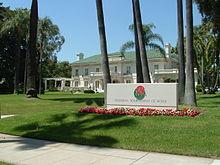
The Norton Simon Museum is at the intersection of Orange Grove and Colorado Boulevards. This corner is the official start of the Rose Parade route and the museum can be quite clearly seen every year during the parade television broadcast.
Orange Grove Boulevard is one of several exclusive residential districts in Pasadena, and has been a home for the rich and famous since the early 20th century. Because of the number of landmark mansions, the street earned the name Millionaire's Row, an appropriate sobriquet considering that the estates that once lined this spacious boulevard and the surrounding neighborhood read like a Who's Who of American consumer products.
The maker of Wrigley's chewing gum, William Wrigley Jr.'s, substantial home was offered to the city of Pasadena after Mrs. Wrigley's death in 1958, under the condition that their home would be the Rose Parade's permanent headquarters. The stately Tournament House stands today, and serves as the headquarters for the Tournament of Roses Parade. Adolphus Busch, co-founder of Anheuser-Busch, brewer of Budweiser beer, established the first of a series of Busch Gardens in Pasadena. When Busch died at his Pasadena estate, his wife generously offered the property to the City of Pasadena, an offer the city inexplicably refused. Henry Markham, who lived adjacent to Busch, was the 18th Governor of the state of California (1891 ae1895) and wrote Pasadena: Its Early Years. The home of David Gamble, son of consumer product maker James Gamble of Procter & Gamble, is located on the north end of Orange Grove Boulevard.
The Gamble House, an American Craftsman masterpiece, was built in 1908, by architects Charles and Henry Greene, as an exemplification of their ultimate bungalow. It is open to the public as both an architectural conservancy and museum.
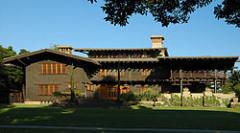
The Gamble House is a California Historical Landmark and a National Historic Landmark on the National Register of Historic Places. In 1966, it was deeded to the city of Pasadena in a mutual agreement with the University of Southern California School of Architecture. Every year, two fifth-year USC architecture students live in the house full-time. The students change yearly.
The home of Anna Bissell McCay, daughter of carpet sweeper magnate Melville Bissell, is a four-story Victorian home, on the border of South Pasadena. Today the Bissell House is a bed and breakfast. Thaddeus S. C. Lowe's home of 24,000 square feet (2,200 m2) was on South Orange Grove. The house included a sixth story solarium which he converted into an observatory. Lowe was also a generous patron of the astronomical sciences. He started a water-gas company, founded the Citizens Bank of Los Angeles, built numerous ice plants, and purchased a Pasadena opera house. He also established the Mount Lowe Railway in the mountains above Pasadena and eventually lost his fortune. The brilliant, but troubled, rocket scientist John Whiteside Parsons sometimes shared his residence with other noteworthy people, including L. Ron Hubbard, the founder of Scientology. Parsons died in an explosion while testing a new rocket fuel in his Pasadena home laboratory, in 1952.
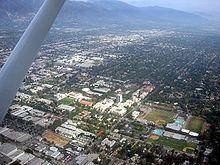
The California Institute of Technology is in the southern-central area of Pasadena. The Jet Propulsion Laboratory (managed for NASA by Caltech) is in Pasadena. Caltech's 31 Nobel Laureates have brought 32 Nobel Prizes home to Pasadena. In 2005, Caltech dedicated an on-campus weather station honoring the late Nobel laureate geneticist and meteorologist Ed Lewis. The Ed Lewis Memorial Weather Station generates weather information for KNBC and thousands of other Web sites on school campuses in Pasadena and all over the nation.
Fuller Theological Seminary, one of the largest multidenominational seminaries in the world, sits just east of downtown Pasadena.
The Le Cordon Bleu College of Culinary Arts (formerly known as the California School of Culinary Arts) is located at East Green Street and South Madison Avenue. The school offers the Le Cordon Bleu accreditation and has two campuses in Pasadena.
Pacific Oaks College is located next to Pasadena's National Historic Landmark, the Gamble House.
Art Center College of Design has two campuses in Pasadena aea Hillside Campus in the San Rafael Hills overlooking the Rose Bowl and South Campus at the southern edge of town. Art Center offers an array of visual and applied art programs and ranks as one of the top five art schools in the United States and one of the top 10 art schools worldwide.
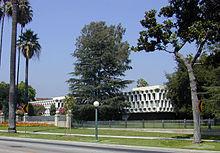
Los Angeles Music Academy College of Music, founded in 1996, is a contemporary music school whose acclaimed faculty of experienced professionals are active in the film, television and recording industries. The school is located between Colorado and California Boulevards on South Fair Oaks Boulevard.
Pasadena City College is a highly rated community college founded in 1924 and located on Colorado Boulevard, slightly northeast of Caltech. Until about 1970, the Rose Parade Queen's court was exclusively selected from its students. PCC alumni include Jackie Robinson, Jaime Escalante, and Octavia E. Butler.
The Pasadena Unified School District encompasses 76 square miles (200 km2) and includes Pasadena, Altadena and Sierra Madre. There are 17 K-5 elementary schools, five middle schools, and four high schools. There are also a number of private and parochial schools in the city.
Pasadena had a public library before it was incorporated as a city. The Pasadena Central Library was designed by architect Myron Hunt and dedicated in 1927. The library has an area of 110,000 square feet (10,000 m2) and was recently renovated without damaging any of its historic integrity. It has been the scene of scholars in movies too numerous to mention. It is listed on the National Register of Historic Places.
According to the City's 2011 Comprehensive Annual Financial Report, the top employers in the city are:
Other companies based in Pasadena include Avery Dennison, Cogent Systems, East West Bank, Inter-Con Security, Jacobs Engineering Group, OneWest Bank, Tetra Tech, Wesco Financial, OpenX, and Wetzel's Pretzels. The Los Angeles-area office of China Eastern Airlines is located in Pasadena.
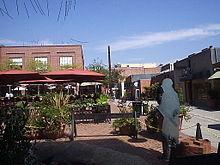
Old Town Pasadena spans 21 blocks downtown. It boasts upscale retail shops and a wide variety of restaurants, nightclubs, outdoor cafes, pubs, and comedy clubs. "One Colorado" features renovated historic architecture that attracted the new retail stores and restaurants. This development filled vacant buildings and was the impetus of the revitalization of Old Town on Colorado Boulevard. Paseo Colorado is an upscale shopping mall designed to be a modern urban village. An open-air mall that covers three city blocks, Paseo Colorado is anchored on the west end by upscale grocery store Gelson's, on the east end by Macy's and Arclight Cinemas centers the middle portion of the mall. Another shopping district is located in the South Lake Avenue neighborhood. On Lake Avenue, an old Macy's department store and furniture gallery is in a registered California historical landmark. The building was originally designed and built as the fourth Bullock's department store in the mid 1950s (the last freestanding store they constructed).
The Rose Bowl Flea Market is a large swap meet that involves thousands of dealers and tens of thousands of visitors in and around the grounds of the Rose Bowl. The merchandise on display ranges from old world antiques to California pottery to vintage clothing. The flea market has been held every second Sunday of the month, rain or shine, since 1967.
Pasadena has a hot-summer Mediterranean climate (Koppen climate classification Csa). Because of its position both higher and further inland than Los Angeles, it experiences slightly colder winters and slightly hotter summers. Winters are typically cold and wet, with heavy rains and January night temperature often below freezing. Spring is consistently mild, and summer becomes gradually warmer and lasts into October. Fall is short and erratic; often cold, rainy days will be followed by hot, dry ones.
The wettest year was 1983 with 48.47 inches (1,231 mm) and the driest year was 1947 with 5.37 inches (136 mm). The most rainfall in one month was 19.70 inches (500 mm) in February 1980. The most rainfall in 24 hours was 7.70 inches (196 mm) on March 2, 1938. Pasadena averages 21 inches (530 mm) of rain a year, about 6 inches more than nearby Los Angeles due to the rain shadow effect created by the San Gabriel Mountains. Because of the slope on which the city is built, sewer lines in the city's northern section have been known to overflow spectacularly.
Situated at the base of the San Gabriel Mountains, snow is known to fall occasionally in Pasadena. The heaviest snowfall in Pasadena history occurred on January 11, 1949; 6 inches fell at Pasadena's city hall and more than 12 inches (300 mm) fell in the foothills of the city. The most recent snowfall in Pasadena was 1 inch (25 mm) on February 26, 2011.
On November 30 and December 1, 2011, Pasadena, along with surrounding communities, was struck by a major windstorm caused by Santa Ana winds. The city suffered heavy damage with trees toppled, buildings damaged and even the roof of a gas station torn off. Some[who?] dubbed the event "Hurricane Rose".
The Civic Auditorium is on Green Street. It was designed to be the south cornerstone of Pasadena's Civic Plaza. Every year, the popular television competition, American Idol films their "Hollywood Week" show there. It was also the venue for the Miss Teen USA 2007 pageant. The main auditorium is large enough to have been home to the annual Emmy Awards ceremony for nearly 25 years, from 1977 to 2001.
Pasadena is the setting of many TV shows including Brothers & Sisters and The Big Bang Theory. Pasadena Community Access Corporation oversees four television stations: The Arroyo Channel (Channel 32), KPAS (Channel 3), KLRN (Channel 95) and PCC TV (Channel 96).
Pasadena has been home to a number of notable radio stations. In 1967 radio iconoclasts Tom and Raechel Donahue took over an aging studio in the basement of the Pasadena Presbyterian Church and introduced Los Angeles to FM freeform radio. Broadcasting under the KPPC-FM call sign at 106.7 FM it quickly became the voice of the counterculture and provided the soundtrack to LA's hippie era. Early on-air personalities included Michael McKean, David Lander, Harry Shearer, and Dr. Demento. The staff was fired en masse in 1971 and the station lost its distinctive personality. KPPC later went on to become KROQ-FM and AM.
Today the primary radio station in Pasadena goes by the call sign KPCC located at 89.3 FM. Broadcasting from the Pasadena City College campus, this public radio station carries many shows from National Public Radio but maintains an independent streak, committing a large chunk of air time to presenting local and state news. Accordingly, the station has received numerous awards for journalistic excellence and continues to be an important part of the city's heritage.
Pasadena's largest newspaper is the Pasadena Star-News, which was first published in 1884. The alternative Pasadena Weekly is published by Southland Publishing. The Pasadena Sun, a community weekly, is published by The Los Angeles Times. The Pasadena Journal, is also a community weekly featuring the Black voices of the San Gabriel Valley. The DENA Magazine, is an entertaining and informative local publication featuring the Inspirational, Influential and Independent nature of Pasadena, it's community, and all of The San Gabriel Valley.
Pasadena has a large, non-indigenous population of naturalized parrots. According to the "Parrot Project of Los Angeles", the parrots are of at least five species. Some residents have come to enjoy the birds as part of their unique city's culture, while others consider them to be loud pests. Many theories surround the mystery of how the parrots landed in Pasadena and claimed the area as their own. A widely accepted story is that they were part of the stock that were set free for their survival from the large pet emporium at Simpson's Garden Town on East Colorado Boulevard, which burned down in 1959.
Pasadena has eight sister cities, as designated by Sister Cities International:

A The number of people counted statistically in demographics will sometimes exceed 100% because some Hispanics and Latinos identify as both White and Hispanic. See Race and ethnicity in the United States census.
Word Count: 6963






